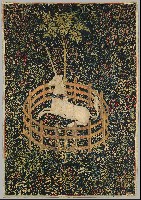1. History
Juliette Warmenhoven's work refers to the practice of elevating the significance of a precious object by isolating, surrounding, and protecting it, a tradition found throughout the world's cultures over time. Examples include the magnificent philatories and monstrance of the middle-ages in which relics of revered saints were enshrined. Their bones or other fragments were considered more valuable than gold or silver, and the representation of the physical remains of a saint outshone their bejeweled encasements. Think of St. Peter's Basilica in Rome, built to house St. Peter's precious bones in a series of successive and ever-more opulent enclosures, ultimately surrounded and embraced by the splendid Bernini colonnade, as an extreme version of this concept.
-
Such enclosures can be metaphoric as well.
The world-famous Unicorn Tapestries (1) depict
a loosely tethered unicorn, calmly sitting in a
meadow filled with flowers, surrounded by a
simple low fence. He looks willing to be
enclosed—it's clear he could escape if he
wanted to. The interpretations are many. In
one, the noble, mythical animal represents the
tamed young groom content to be bound in
his marriage by his love. In another, the scene
represents the conclusion of a successful hunt
for a rare and exquisite trophy, perhaps of
deep personal significance. | 
|
2. Memory
That impulse to house something of significance that connects us to our past is universal, and Juliette Warmerhoven's Memory Collectors are aesthetic mini-monuments and altars—reliquaries in which precious objects, imbued with meaning and carrying layers of information, are preserved. The antithesis of the medieval lavishness, their fine black screws spiraling around a column are architectural in their conception, at once minimalist and baroque.
They are executed with devotional detail and precise handiwork that evoke sacred concepts of collecting, containing, and saving the emotions that make us human—connection, love, and loss. Whether enclosed by architecture, a fence, or a miniature container so lovingly and precisely made, they are meant to enshrine the precious, the fugitive—the experience of life and love.
3. Nature
Juliette Warmenhoven's studio is in an historic warehouse, built originally to store tulip bulbs, near the North Sea. I see the building as a treasure chest of potential—for beauty and, given its role in Dutch history, for riches. She also draws inspiration from being cloistered on the top floor, looking out onto the surrounding natural landscape. In her work she uses elements found in the iconic Dutch landscape and agriculture—sepia, potatoes, and things she finds on the beach or in the garden. Anchoring her work in nature explains how she captures meaning in the elusive cycle of life: How does our existence and experience grow, bloom, and die? Her Memory Collectors provide the opportunity to cherish what is fleeting. A wise inclination in this geological epoch of the Anthropocene (2).
Barbara Krulik, Amsterdam
January 2019
Thanks to Howard L. Moore for his usual expert editing.
1) housed in the Metropolitan Museum's Cloisters in New York
2) the word was coined by Paul Crutzen (born 1933), Nobel-winning Dutch chemist, describing the period, from the Industrial Revolution, in which humanity has had a significant impact on the environment.